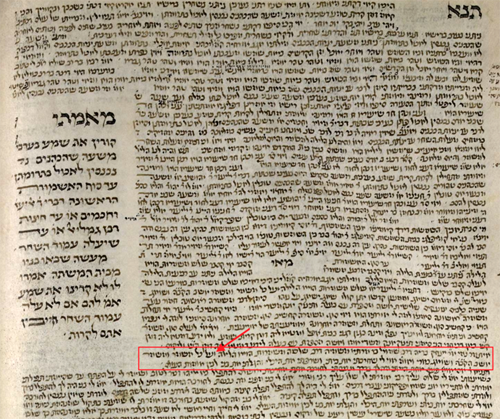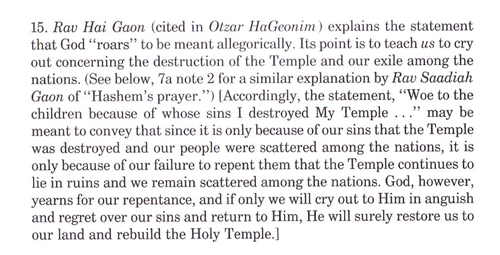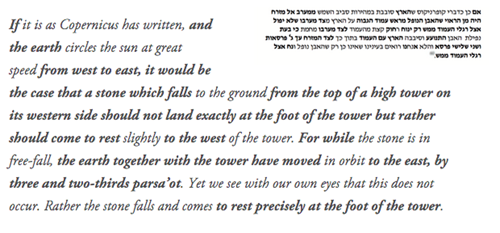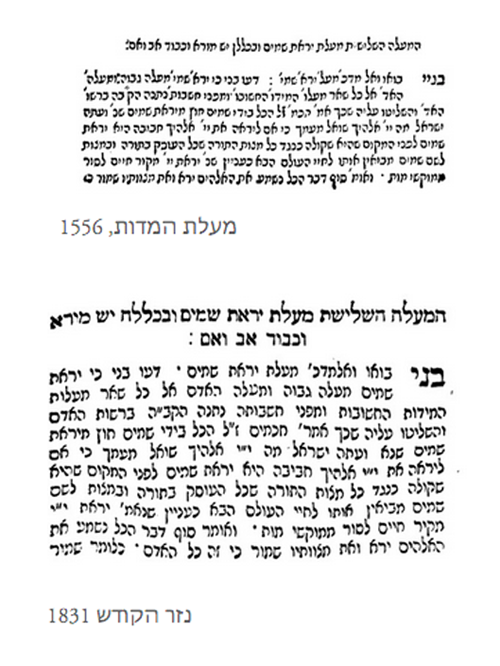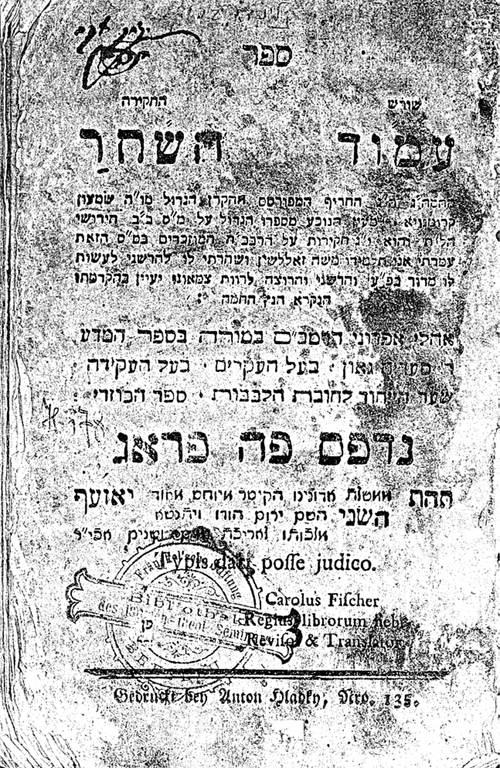A Preliminary Review of The New Koren Talmud Bavli: A Goldilocks edition
by Jeremy Brown
Jeremy Brown lives outside of Washington DC. He is the author of New Heavens and a New Earth: The Jewish Reception of Copernican Thought, to be published later this year by Oxford University Press.
We are only weeks away from finishing the seven-year cycle of Daf Yomi. Right on cue, publishers are ready to meet the demand of those ready to study Daf Yomi the first time as the cycle begins anew, or perhaps students who wish to learn Talmud at a slower pace. We are promised Daf Yomi apps (“apps” did not exist seven years ago) and the publication in English of a new translation and commentary on the Talmud: the Koren Talmud Bavli, with a commentary by Rabbi Adin Even-Israel, better known as Adin Steinsaltz. The team is led by Rabbis Tzvi Hersh Weinreb (formally executive Vice President of the OU) and Joshua Schreier (formally at Midreshet Lindenbaum) both of whom have stellar reputations, and the project will eventually comprise the entire Talmud Bavli in 41 volumes. The regular price of each volume will be $49.95, but Amazon is advertising Berakhot at a significantly discounted rate of $29.54. If these prices are maintained, the entire English Steinsaltz could be purchased for about $1,200; by comparison the entire (full size) ArtScroll English Talmud in 73 volumes, costs about $2,450 – twice as much. Inevitably, comparisons will be drawn to both the older translation by Isidore Epstein and much more recent ArtScroll English translations, and even a cursory glance reveals striking differences between the productions. (To keep things simple, we will refer to the Koren edition as the “Steinsaltz” Talmud; the ArtScroll Schottenstein edition will be called the “ArtScroll” edition; and the translation by Isidore Epstein will be called the “Soncino” edition.)
First, there are significant production differences. While the ArtScroll production team included several women proofreaders, the Steinsaltz team includes women as translators as well as language consultants. This change does not guarantee a better product of course, and the outcome must be judged on the basis of its merits alone. However this approach demonstrates a commitment to a refreshing worldview in Jewish publications in which outstanding scholars are no longer barred from contributing simply because they do not carry a Y chromosome. With the repugnant attempts to marginalize women occurring in some fundamentalist sectors of Jewish society today, the Steinsaltz Talmud reminds us that Talmudic scholarship and teaching are no longer male dominated spheres. It is a message needs to be heard in Jerusalem and in Brooklyn.
Another difference also points to a subtle but palpable embracing of the modern: the approach to transliteration. The Steinsaltz team has adopted a transliteration schema that generally reflects the Academy. Thus the letter ח is transliterated as H with a dot under the letter, a כ is kh, and ת is t. ArtScroll published Berachos, Steinsaltz published Berakhot. Again, such differences do not guarantee a better product, but imply that the Steinsaltz Talmud has an approach that might include lessons from the academy and modern scholarship. Finally, the designers have added a magnificent full color cover to the book, which is both eye-catching but utterly impractical if the volume is to be carried every day since the translucent paper easily scars. Still, there is a simple solution to this. Just remove the cover while learning from the Talmud. If you do this you will notice the warm red tone of the volume, which is remarkably similar to many editions of the standard Hebrew only ש”ס today. Was this a clever way to disguise the book for those who feel the need to do so?
Haskamot
Interestingly the Steinsaltz Talmud includes five haskamot from rabbis who died recently or long ago. Two are from R. Moshe Feinstein dated from 1970 and 1983. An even earlier haskamah from R. Menachem Schneerson, the late Lubavitcher Rebbe, dates from 1969, or some 43 years before the publication of the English edition. There is an undated haskamah from R. Moshe Zevi Neriah who died in 1995, and the final haskamah is from R. Mordechai Eliyahu, who served as the Sephardi Chief Rabbi of Israel and died in 2010. Quite what these haskamot are doing here is not clear; do such things persuade the reader to that the work is indeed appropriate, or do they serve instead as a kind of spiritual shield, meant to deflect any criticism of the project? The five haskamot printed in the Steinsaltz Talmud are all translated, so perhaps the target audience is indeed the reader who is not fluent in Hebrew, although I doubt there is much persuasive power in the haskamah as a book blurb. In comparison, ArtScroll printed twelve signed haskamot, but translated none of them. (Essay question: Compare and contrast the haskamot of the Steinsaltz and ArtScroll editions of the Talmud.)
Introduction
The Steinsaltz Talmud contains an introduction to Masekhet Berakhot which is more or less a translation of the original Hebrew, but generally improves on it. Here perhaps the editors faced an important question: should this opening volume of
ש”ס contain introductory essays about the place of the Talmud in Jewish thought and history, its development and why it must remain a meaningful foundation of Jewish identity? Or should the reader instead be thrown headfirst into the project, learning what Talmud is by, well, learning Talmud. In fact such a guide already exists, written by Steinsaltz and published by Random House in the 1989 English language Reference Guide. This work will soon be reprinted in a re-edited book as part of the larger Steinsaltz English Talmud set. Such a guide will help many of those taking their first steps along the path of Talmud study.
The introduction that is provided is both inspiring and welcoming, as the following will demonstrate. Consider for example, the ArtScroll Talmud, which (after some 37 pages listing the sponsors) opens its introduction to Berachos in this way:
Berachos [“Blessings”] as its name implies, deals primarily with the assorted blessings that are recited at various times and occasions. In essence a ברכה, blessing…is an acknowledgment of God as the Creator of the phenomenon beheld, the Commander of the mitzvah performed or the Provider of the benefit enjoyed.
Here in comparison is the Steinsaltz introduction: “Tractate Berakhot is the first tractate in the order of “Faith.” The primary focus of the tractate is the myriad ways in which a Jewish person expresses faith throughout his life.” There is a certain grandeur here that is captured, a certain look at the big picture that lies behind the detailed halakhic discourse. This theme is echoed later in the introduction when the reader wonders just how the detailed halakhic path can lead to greater appreciation of the divine.
Furthermore, faith, despite its broad scope, is not a palpable presence, in one’s daily life. True, faith as Weltenschauung and as a general approach exists, in one form or another in the hearts of all people, at different levels of consciousness and acceptance. However, the difference between that faith and real life is too significant. There is no comparison between accepting the fundamental tenets of faith in one’s heart and fulfilling them in practice, especially at all of those minor, uninspiring opportunities that constitute a majority of one’s life. If the abstract concepts of faith are not manifest in a practical manner in all of the details of a person’s life, faith will loose its substance; consequently all of life’s details will be rendered worthless and pointless. Indeed the fundamental demand of religion is well characterized in the phrase “if you devote your heart and your eyes to Me, I know that you are mine.”
This introduction addresses one of our great challenges, and yet it is rarely acknowledged. Every day life is often, well, just ordinary everyday life. Although we may, at times, be keenly aware that life is a gift that cannot be taken for granted, in truth, there are many “minor and uninspiring” moments, and these do indeed constitute the majority of life. Yes, there is indeed chasm that separates faith and real life, and the introductory essay addresses this existential reality head on.
Content
The layout of the Talmud is a radical departure from that of the Vilna
ש”ס and follows the earlier decision of Steinsaltz when his Hebrew translation and commentary no longer stuck to the Vilna format. In that version each single amud was split into two pages, whereas in this English edition there is no allotted page format, and hence no automatic rubric that ties the page of the English translation with that of the Vilna
ש”ס . For the ArtScroll translation the need to retain the look and feel of the Vilna
ש”ס was a guiding editorial principle that resulted in the same Hebrew page being reproduced several times in order to accommodate the English translation alongside. The editors of the Steinsaltz Talmud made the wise decision that assumed their reader would be comfortable reading a page of Talmud in a form that no-longer resembled the standard page of Talmud, and the decision works. Should the reader wish to refer to the page of the Vilna
ש”ס , the entire masekhet is reproduced at the back (or front depending on your orientation) of the volume but with the addition of vowels. The result is that Masekhet Berakhot is in one volume, unlike the ArtScroll edition in which the Berachos is spread over two.
Despite this break with traditional formatting, the Steinsaltz page maintains a Talmudic feel with its central text in Hebrew to the left of the English translation, surrounded by notes, just as in the Vilna
ש”ס there is a central Talmudic text surrounded on three sides by later commentaries. In the original Hebrew Steinsaltz edition the various comments were largely to be found at the bottom of the page, whereas in the English edition they are where Rashi and Tosafot are usually to be found. The result is a central ancient text surrounded by later comments – which is very Talmudic indeed.
The actual text is a pleasure to read, using Koren’s by now very familiar fonts. Phrases in Hebrew are widely separated from each other, and the English translations are also printed in a paragraph style, rather than as a running text, which was generally how it appears in the ArtScroll. The Steinsaltz presentation is, as a result, a greater pleasure to read and the Talmudic arguments are easier to follow than the page presented in either the traditional Vilna format or as translated in the ArtScroll or Soncino editions. Small notes direct the reader of the English text to notes found at the borders of the page. Like the original Hebrew Steinsaltz, these comprise of Notes on the Talmudic discussion, Background on material, Halakha (which references the Shulhan Arukh and Rambam), Language and Personalities. These notes are supplemented with high quality color illustrations (although only in black and white in the Steinsaltz Daf Yomi edition). The illustrations are generally a superb addition and aid. In a discussion of ritual impurity (36b), the illustration of the crown of the pomegranate is critical to understanding the text. Similarly the illustration of the issar (28b), a small coin, helps the reader understand the discussion. However the text states an opinion that one must bend down during the Amidah “until he can see an issar [on the ground]” so here the discussion might have been better illustrated with a reproduction of the actual size of the coin since this is most germane to the issue. Some illustrations are vital – like that of a katedra or chair from the Talmudic era (43a) which was significantly different from the modern chair, and Talmudic era burial cave (14b). Others seem rather unnecessary; does the modern reader really need a color picture of a lion (56b) or elephant (57a)? And there are some errors too: Ursa Major is not “the largest a star in Taurus” (59a). Indeed it is not a star at all, but rather a constellation. Nor is it “the eye of the ox;” that would be Aldebaran. Elsewhere we correctly learn that polycythemia vera is one of the only conditions for which bloodletting remains an effective therapy. This is true, but the description of the disease causing excessive bleeding from the gums and from ordinary cuts is not; that would be hemophilia. (There is a subgroup of patients with PV who have thrombocytosis and dysfunctional platelets in whom bleeding can occur, but this is an obscure detail). Perhaps, to complement the impressive group of translators and language consultants, the publisher should add a scientific consultant. These (relatively) minor quibbles aside, the notes provide important clarifications and points of interest which change the often dry Talmudic texts into accessible and even enjoyable reading material.
The censored text
The publisher’s preface to the Steinsaltz Talmud notes that the standard “Vilna edition was read against other manuscripts and older print editions, so that texts which have been removed by non-Jewish censors have been restored to their rightful place.” This is evident with the inclusion of a censored text on 17b in which the censored Vilna (and ArtScroll) text reads שלא יהא לנו בן או תלמיד שמקדיח תבשילו ברבים . The original uncensored text identified the student who caused others to sin by name:שלא יהא לנו בן או תלמיד שמקדיח תבשילו ברבים כגון ישו הנצרי. No mention of the censored text is mentioned in the ArtScroll Talmud, which instead directs the reader to the Ritva “for a specific reference.” The Ritva indeed mentions the reference to Jesus, but why did ArtScroll decline to amend the censored text? Of what precisely, were they afraid?
This is not an isolated example. The text of the Talmud is also censored on 3a. The original uncensored text reads אוי לי שהחרבתי את ביתי ושרפתי את היכלי והגליתים לבין אומות העולם
However the Hebrew text of the English ArtScroll (and the Soncino) reads as follows:
אוי לבנים שבעונותיהם החרבתי את ביתי ושרפתי את היכלי והגליתים לבין אומות העולם
The additional words לבנים שבעונותיהם were added by Christian censors and the corrupted text was noted in Dikdukei Soferim. None of was evident to the editors of the English ArtScroll, who compounded the error by adding the following homiletic note to the corrupted text.
In its effort to comment on (nearly) everything, the ArtScroll edition has added a homiletic explanation of a text written (almost certainly) by a Jewish apostate serving as Christian censor. Fortunately, the Hebrew and English editions of the Steinsaltz, together with the Hebrew Schottenstein (ArtScroll) have returned the text to its original and uncensored form.
While the number of such censored Talmudic texts is not especially large, the modern reader should expect no less than the most accurate text of the Talmud, and the editors of the Steinsaltz Talmud seem to have been sensitive to this need.
Side by side comparisons
The real test of the new Steinsaltz Talmud is how it feels to use it, and how that experience compares to the older ArtScroll and much older Soncino translations. What follows is a comparison of a section of text chosen at random. The comments are preliminary; an in-depth comparison of the three editions would require far more space than this review allows. First the Talmud itself, from ברכות ז:
Here is the Soncino translation togther with the foonotes, (which are not found on the same page in the orginal):
Next, the ArtScroll:
And finally the Steinsaltz with the Notes as they appear on the printed page:
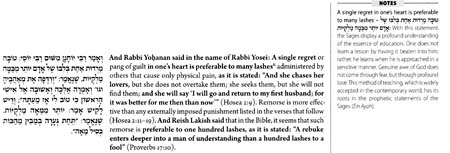
In elucidating the meanings of this passage, the Soncino provides the minimalist approach, which consists of a translation of the biblical verse as it is cited in the Talmud, together with a translation of the comments of R. Yohanan and Resh Lakish. The English text is understandable, but only with some effort. (What exactly are “stripes”?) In order to appreciate the biblical proof text cited the reader would have to look up the verse in its entirety. The notes provided in the Soncino edition are at the foot of the next page, so that in order to know where the verses are from, the reader must divert her attention from the text to the notes. Finally, having studied this passage, the reader is left wondering just why regret is preferable to punishment. Should her skills allow she could read Rashi’s explanation (who emphasizes that regret is reached through a personal reckoning), or provide an explanation of her own.
The ArtScroll translation does more work for the reader, filling in the missing biblical text so that the verse is understood in its entirety without the need to actually reach for a Bible to look it up. But the explanation, like the reference explaining where the verse comes from, is to be found in a footnote under the text, which is distracting. Even more disruptive is the explanation of the verse provided in note thirty-two. It explains how the verse may be understood metaphorically in the context of Hosea’s rebuke of Israel’s infidelity, but this is of no relevance in understanding the Talmud here. Finally, following Rashi’s explanation, the ArtScroll translation of the verse from Proverbs used as the proof text for Resh Lakish is unnecessarily verbose: “The humbleness following from reproof…”
The Steinsaltz Talmud adopts a different approach than the ArtScroll, placing the references into the flow of the text so that the reader never has to search for the biblical citation. Like the ArtScroll translation, it fills in the words missing from the biblical quotes, but it also provides a psychological explanation in the body of its translation, noting that “remorse is more effective than any externally imposed punishment.” The reader’s attention is directed to a note that appears immediately next to, (rather than below and distant from) the text that is being studied, and it here that the text is explained; it reveals an educational methodology in which a student learns best when “approached in a sensitive manner.” This insight is acknowledged to come from Ein Ayeh, although the opportunity to tell the reader that this is a work of Rabbi A. I. Kook was sadly missed. Finally, in its translation of the verse from Proverbs, the less verbose Steinsaltz translation is more germane and better understood: “A rebuke enters deeper into a man of understanding…”
The Soncino translation, once of great service as the only English translation, uses language that is anachronistic. It is difficult to use, and lacks the kinds of explanations that the modern reader is looking for. The ArtScroll translation is busy both esthetically and in its content, with so many references that the reader is often not able to distill what is of true value – namely, understanding the meaning of the Talmud and using it whenever possible to guide contemporary Jewish living. The Steinsaltz approach provides a Goldilocks translation, one that is just right, providing the reader with enough detail and explanation to discern the meaning of the Talmud, and to leave its study with a profound lesson that is applicable to contemporary society. For the student who wishes to study the Talmud in depth but who lacks the Hebrew skills to do so, the ArtScroll translation provides plenty of references and additional material. For the more casual student, and for the reader engaged in the challenge of following the Daf Yomi cycle, the Steinsaltz translation is more readable and the page less overwhelming, without sacrificing any of the ability to understand the text itself. Less is certainly more. Much more.
Conclusion – the Talmud evolves
Writing some one hundred and forty years ago, Raphael Nathan Rabbinovicz described the 1554 edition of the Sabbioneta Masekhet Kiddushin as “the most becoming and beautiful. If the entire Talmud had been printed, it would have been the glory and most beautiful jewel of Israel. All the editions before and after would not have compared to it…” The new English Steinsaltz Masekhet Berakhot deserves no less an accolade. Aesthetically attractive, and containing new and important elucidations of the text, it is not simply a “me-too” translation, but a statement of the relevance and evolution of the central text of rabbinic Judaism. It deserves a place on the shelf of every English speaking modern-Orthodox house and Bet Midrash, or better yet, every English speaking Jewish home. The Koren Steinsaltz Talmud invites us to savor the Talmud. It shows us that far from being a work that is difficult and at times frustratingly opaque, the Talmud can be a colorful work that is not only easy to understand, but a pleasure to read. Ravina and Rav Ashi would have been proud.

